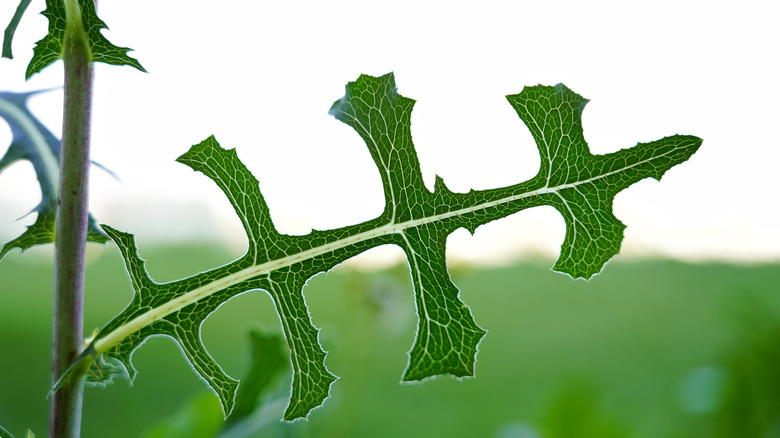Fall Is The Best Time To Stop These Lawn Weeds In Their Tracks
You may have concerns about controlling weeds in your lawn throughout the growing season, always trying to figure out the best time to apply weed and feed to give the grass plants the nutrients they need while eliminating the unwanted plants. You also can deploy numerous tricks to try to eliminate weeds, including mowing at the right length to keep weeds down or spraying chemicals directly on the unwanted plants. When it comes to certain pesky weeds, though, attacking them during particular times of the year will give you the best results. With broadleaf plants like prickly lettuce, buckhorn plantain, and broadleaf plantain, autumn is the best time to make efforts to eliminate them because they are just coming out of their flowering seasons in September. This makes them easier to identify, so you can attack them successfully.
Because unwanted broadleafs like these tend to germinate after the flowering season, you want to try to kill them during the autumn. Controlling them in the autumn is also beneficial because any seedlings are weak, making them easier to eliminate.
You have the option of pulling these weeds, or you can use granular and liquid chemical control methods. Pulling established, mature broadleaf plants is a challenge because the roots tend to break off and remain viable. Consider watering the area to soften the soil to make pulling the entire root easier. If you decide to use granules or sprays, select one that's effective against broadleaf plants but safe for your grass.
How to identify and eliminate prickly lettuce weeds in the autumn
Prickly lettuce is most common throughout the Great Plains, and it can appear in fields, yards, and gardens. Also called spiky lettuce, it typically has oval-shaped leaves when it's a seedling or a young plant. The leaves can be lobed or unlobed on the mature plant, which can reach up to 6½ feet in height. It has some prickly bristles along the leaves and the stem. Its flowers are pale yellow in color and look a bit like flowers from a dandelion. Spiky lettuce flowers are numerous per plant and are small.
Attacking this weed in the fall is helpful to catch the plant during its germination period. The small plants have several oval leaves tight to the ground. This is the easiest time to pull the prickly lettuce plant and eliminate it.
If you choose to use a herbicide, make sure it contains glyphosate, glufosinate, or paraquat. Applying it in the fall is helpful in preventing the plant from growing back in the spring. The plant naturally is weaker during the winter as it tries to survive low temperatures, so weakening it further just before these temperatures arrive can be the difference in the plant surviving the winter. Additionally, spraying the weed killer in the autumn can make it more effective against broadleaf plants like spiky lettuce because they are at their most vulnerable after the primary growing season and flowering period.
Why attempting to kill plantain weeds works best in autumn
The plantain weed is another broadleaf plant, meaning you can use many of the same measures to try to eliminate it as you used on the prickly lettuce. Plantain grows low to the ground with leaves that have noticeable parallel veins. Its leaves grow from the base of the plant, slightly overlapping to form a rosette. A mature buckhorn plantain may have narrow, lance-shaped leaves up to 10 inches in length, while the mature broadleaf plantain's oval-shaped leaves are up to 7 inches in length. The flower spikes from this weed are up to 18 inches in height and do not have leaves on them. They produce tiny white flowers along the stem but primarily at the top.
Pulling these weeds in the autumn is an effective means of controlling them, especially right after they germinate. Spraying a weed killer directly on the plants in the fall helps the chemicals to reach the root system. This weakens the plant significantly during the cold weather of winter, making it far more difficult for the plant to recover during the spring.
If you are seeing plantain seedlings emerge during the fall, this is a great time to cover them with mulch. Organic mulch at least 3 inches in depth is helpful for cutting off sunlight to these young plants, making them unable to gain the strength they need to survive the wintertime. Some people use landscape fabrics to eliminate the seedlings.


